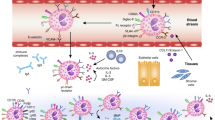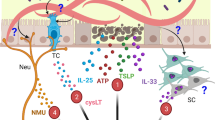Abstract
The connective tissue of rats, and several other species of mammals, contains two distinct types of mast cells that differ in morphology, histochemical staining properties and location1. One type, frequently called the normal connective tissue mast cell, can be obtained in nearly homogeneous preparation from a mixed cell population in the peritoneal cavity and forms the basis of our knowledge of mast cells. The other type is referred to as the mucosal mast cell because in normal rats it has been observed only in mucosal tissue. Infection with helminth parasites induces an extensive accumulation of mast cells and eosinophils in the tissues1,2, and parasites of mucous surfaces, in particular, stimulate a rapid hyperplasia of mucosal mast cells3,4. However, the origin of mucosal mast cells, and their relationship to the connective tissue mast cells is uncertain. We now show that lymphocytes of helminth-infected rats, on in vitro stimulation with specific antigen, release factors causing pronounced mucosal mastocytosis in normal rat bone marrow cultures.
This is a preview of subscription content, access via your institution
Access options
Subscribe to this journal
Receive 51 print issues and online access
$199.00 per year
only $3.90 per issue
Buy this article
- Purchase on Springer Link
- Instant access to full article PDF
Prices may be subject to local taxes which are calculated during checkout
Similar content being viewed by others
References
Askenase, P. W. Springer Semin. Immunopath. 2, 417–442 (1980).
Jarrett, E. E. E. & Miller, H. R. P. Prog. Allergy 31, 178–233 (1982).
Murray, M. in Immunity to Animal Parasites (ed. Soulby, E. J. L.) 155–190 (Academic, New York, 1972).
Mayrhofer, G. Cell. Immun. 47, 304–311 (1979).
Ruitenberg, E. J. & Elgersma, A. Nature 264, 258–260 (1976).
Mayrhofer, G. & Fisher, R. Immunology 37, 145–155 (1979).
Mayrhofer, G. & Bazin, H. Int. Archs. Allergy 64, 320–331 (1981).
Nawa, Y. & Miller, H. R. P. Cell. Immun. 42, 225–239 (1979).
Enerback, L. Monogr. Allergy 17, 222–232 (1981).
Woodbury, R. G., Gruzenski, G. M. & Lagunoff, D. Proc. natn. Acad. Sci. U.S.A. 75, 2785–2789 (1978).
Woodbury, R. G. et al. Proc. natn. Acad. Sci. U.S.A. 75, 5311–5313 (1978).
Jarrett, E. E. E. & Bazin, H. Nature 251, 613–614 (1974).
Ginsburg, H. & Lagunoff, D. J. Cell Biol. 35, 685–697 (1967).
Denburg, J. A., Befus, A. D. & Bienenstock, J. Immunology 41, 195–202 (1980).
Schrader, J. W. J. Immun. 126, 452–458 (1981).
Nabel, G., Galli, S. J., Dvorak, A. M., Dvorak, H. F. & Cantor, H. Nature 291, 332–334 (1981).
Tertian, G., Yung, Y-P., Guy-Grand, D. & Moore, M. A. S. J. Immun. 127, 788–793 (1981).
Ginsburg, H., Ben-Shahar, D. & Ben-David, E. Immunology 45, 371–380 (1982).
Ginsburg, H., Olson, E. C., Huff, T. F., Okudaira, H. & Ishizaka, T. Int. Archs Allergy 66, 447–458 (1981).
Kitamura, Y., Yokoyama, M., Matsuda, H., Ohno, T. & Mori, K. J. Nature 291, 159–160 (1981).
Crowle, P. K. Fedn Proc. 41, 581 (1982).
Miller, H. R. P. Lab. Invest. 24, 339–347 (1971).
Sumner, M. A. et al. Br. J. Haemat. 23, 221–234 (1972).
Jennings, F. W., Mulligan, W. & Urquhart, G. M. Expl Parasit. 13, 367–373 (1963).
Iscove, N. N. & Melchers, F. J. exp. Med. 147, 923–933 (1978).
Karnovsky, M. J. J. Cell Biol. 27, 137A–138A (1965).
Katunuma, N. et al. Eur. J. Biochem. 52, 37–50 (1975).
Author information
Authors and Affiliations
Rights and permissions
About this article
Cite this article
Haig, D., McKee, T., Jarrett, E. et al. Generation of mucosal mast cells is stimulated in vitro by factors derived from T cells of helminth-infected rats. Nature 300, 188–190 (1982). https://doi.org/10.1038/300188a0
Received:
Accepted:
Issue Date:
DOI: https://doi.org/10.1038/300188a0
This article is cited by
-
Short-term in vitro culture of purity and highly functional rat bone marrow-derived mast cells
In Vitro Cellular & Developmental Biology - Animal (2018)
-
Role of T lymphocytes in intestinal mucosal injury
Digestive Diseases and Sciences (1992)
-
Cellular reactions in the small intestine of rats after infection withFasciola hepatica
Parasitology Research (1991)
-
Corticosteroid treatment reduces mast cell numbers in inflammatory bowel disease
Digestive Diseases and Sciences (1990)
-
Association of maturation of the small intestine at weaning with mucosal mast cell activation in the rat
Immunology & Cell Biology (1988)
Comments
By submitting a comment you agree to abide by our Terms and Community Guidelines. If you find something abusive or that does not comply with our terms or guidelines please flag it as inappropriate.



